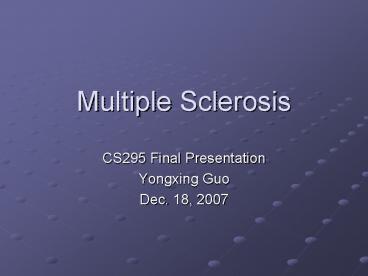Multiple Sclerosis - PowerPoint PPT Presentation
1 / 19
Title:
Multiple Sclerosis
Description:
What's Multiple Sclerosis (MS) First described by Charcot in 1868. ... In 1972, the association between multiple sclerosis and the HLA region of the ... – PowerPoint PPT presentation
Number of Views:630
Avg rating:3.0/5.0
Title: Multiple Sclerosis
1
Multiple Sclerosis
- CS295 Final Presentation
- Yongxing Guo
- Dec. 18, 2007
2
Outlines
- Introduction to Multiple Sclerosis (MS)
- Genomewide Association Study of MS
- IL2RA IL7RA and MS risk
- Comments
3
Whats Multiple Sclerosis (MS)
- First described by Charcot in 1868.
- A chronic inflammatory disease of the central
nervous system (CNS), the brain and the spinal
cord. - A malfunction of the immune system which leads to
attacks against, and causes destruction of the
myelin sheath. - Symptoms range from mild muscle weakness to
partial or complete paralysis. - Widely considered an autoimmune disease
4
Epidemiology of Multiple Sclerosis
- Monozygotic twins concordance rate is nearly 30
- Siblings or dizygotic twins 2
- Average Northern European population 0.1
- Both genetic predisposition and largely unknown
environmental factors are required to cause the
disease
5
Association between MS and the HLA MHC Complex
- In 1972, the association between multiple
sclerosis and the HLA region of the genome was
established. - HLA-DRB1 gene on chromosome 6p21 was identified.
The human leukocyte antigen system (HLA) is the
name of the human major histocompatibility
complex (MHC). This group of genes resides on
chromosome 6, and encodes cell-surface
antigen-presenting proteins and many other genes.
The major HLA antigens are essential elements in
immune function
6
Other Studies of MS
- No other loci with a definitive association with
the disease have been found. - Early efforts to screen the genome for linkage
with the use of low-density maps of
microsatellites were unsuccessful. - These results indicate that in multiple
sclerosis, linkage studies lack the statistical
power to detect susceptibility loci that may
reside outside the HLA-MHC region.
7
(No Transcript)
8
Overview
- A genomewide association study
- A transmission disequilibrium test of 334,923
single-nucleotide polymorphisms (SNPs) was
performed - A joint analysis of data from 12,360 subjects
was performed - Alleles of IL2RA and IL7RA and those in the HLA
locus are identified as heritable risk factors
for multiple sclerosis
9
(No Transcript)
10
Quality Control of Genotyping
MAF Minor Allele Frequency HW Hardy
Weinberg Equilibrium ME Mendelian Errors
11
Screening Analysis
WTCCC Wellcome Trust Case Control
Consortium NIMH National Institute of Mental
Health IMSGC International Multiple Sclerosis
Genetics Consortium
12
Replication Analysis
13
Overview of the Primary Genomewide Association
Scan Involving 931 Family Trios
P values (shown as log10 values) for results of
transmission disequilibrium testing are plotted
across the genome. The classic HLA-DR risk locus
on chromosome 6p21 stands out with strong
statistical significance (Plt110-81).
14
Observed and Expected Distributions for the
Results of Transmission Disequilibrium Testing
Red The expected null distribution Gray
P values for all 334,923 SNPs Black The
observed distribution after exclusion of the
SNPs across the extended HLA region
15
(No Transcript)
16
Regional Plots for Associations in IL2RA
17
Regional Plots for Associations in IL7RA
18
Whats IL2RA IL7RA
- Both are important in are important in T-cell
mediated immunity - IL2RA
- The interleukin-2 receptor (IL-2R) is
heterotrimeric protein expressed on the surface
of certain immune cells, such as lymphocytes,
that binds and responds to a cytokine called
interleukin 2. - Linked to two other autoimmune diseases type 1
diabetes and autoimmune thyroid disease. - IL7RA
- The protein encoded by this gene is a receptor
for interleukine 7 (IL7) - Helps to control the activity of a class of
immune cells called regulatory T cells. - IL7RA variant indicate an effect on gene
expression with a change in the ratio of soluble
to cell-bound interleukin-7 receptor
19
Comments
- This is a hypothesis free association study.
- The increased risk contributed by IL2RA and IL7RA
is very low and that these two alleles explain
only a very small proportion of the variance
(0.2) in the risk of MS. - Complex disease association studies need a
massive number of study samples and the
collaboration of large consortia because of the
small effect of common alleles. - No clues to new pathways emerged from among the
top-scoring associations, in contrast to the
results of some genomewide studies involving
other complex diseases, such as type 2 diabetes. - The best-associated variants in the combined data
analysis were actually not among the best hits in
the initial screen - Genomewide association studies that rely on
common SNPs monitor only common alleles































